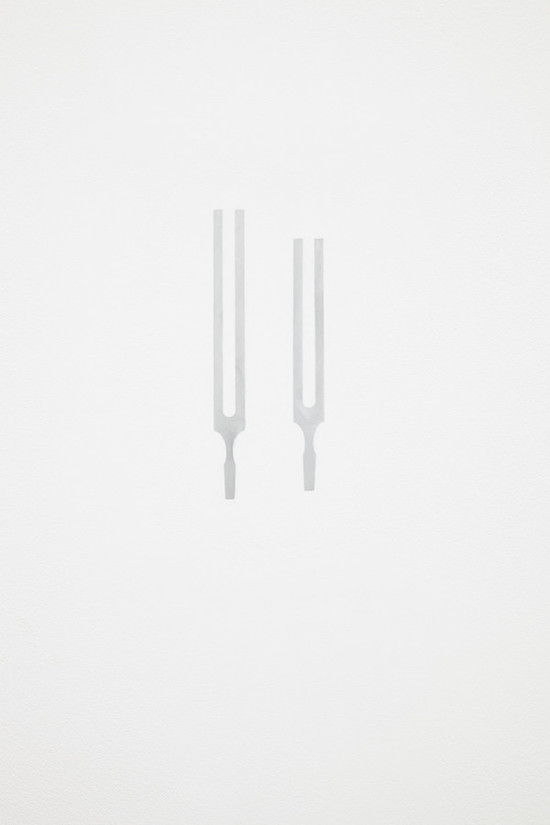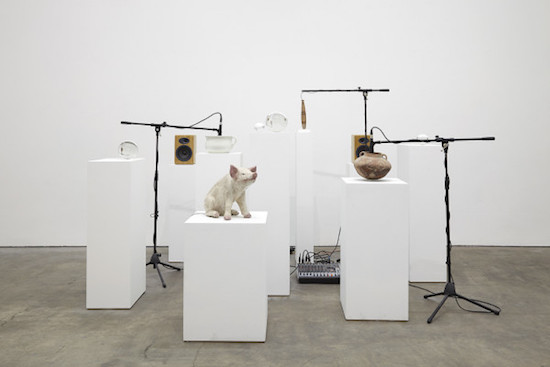Present as you walk into the reception space at Ikon is a permanent work by Oliver Beer. Outside-In, installed in 2013, is an intervention directly into the gallery space in which a window pane has been replaced with a sculptural work shaped like an ear trumpet. The work forms to a point into the gallery, the other end point making a hole that opens to the environment outside.
This work is an unexpected stopping point for a visitor, a place where you encounter a channel of air and sound that seeps inwards from the world outside. It is an open window, an invitation to engage with the breaking of internal and external space.
The work is given the space to articulate its own relationship with the wider building, a site for selfie opportunities or a place for serious listening. From March through to June, Outside-In served as an introduction to Beer’s comprehensive solo exhibition in the upper floor of the gallery.
Sound permeates this exhibition. A disparate set of vessels, including a butcher’s ceramic pig, antiquities from Greece and Palestine, and Beer’s own grandmother’s chamber pot, are set on plinths. The empty space within each is amplified by a microphone and fed through a mixer. These objects are brought together for Making Tristan (2016), with each vessel resonating a specific note – F3, B3, D, and G – which together merge into the famous “Tristan Chord”.
Created by Richard Wagner for the opera Tristan and Isolde, this sound is the brokering of a space within music for the unresolved and speculative, a shift away from certainty. The work hums. The atonality it creates is felt bodily and accumulates as you move through the room.
In a small side room, Birmingham’s Selfridges building moons at Digbeth in a series of establishing shots from the film Pay and Display (2011). Set in Pershore Street Car Park, an emptied grey concrete brutalist megastructure from which the camera looks outwards, the film glances over to Hirst Street, lingers on the steps and the peeling paintwork, and relays the external noise of cars. As seagulls drift through and settle onto the deserted parking bays, another presence builds in the film.
A series of shots show hair, skin, and shoes. We hear a low drone of voices over the blinking of an eye, a mouth and a cloud. The sound of humming rises and rises. It shifts like the migration of birds and gains altitude. The screen blinks and a sonorous teem of voices enquires, “Have you paid and displayed?”
Here the Ex Cathedra choir relay the car park’s manifesto. A young boy looks out. A choir of children’s voices reissue the demand, “Have you paid and displayed?” Then they conspiratorially whisper, “except on Sundays”.
Out of every level of the carpark, there’s a different view of the city. The gulls drift off and we are left with humming, a consciously aware droning that layers the chord emitted from Making Tristan.

Looping on a screen in a corner between the two main gallery rooms is Reanimation (I Wan’na be Like You) (2017). Here, 2,500 Birmingham schoolchildren have coloured in animation stills, with each participant grouped sequentially through from early to teenage years. You watch it as visitors pass through. Some settle with you, some pause seeking engagement then walk through to the next room. These shifts in the audience coalesce with the film, with the presence or absence of image and sound. Wait around for the start and gradually the screen shows the pulsing of marks, they jump haphazardly and cluster to the swing of I Wan’na Be Like You, hit song from the 1967 Disney film, The Jungle Book.
The song is an infectious paean to misbehaviour that has the potency to cause Ikon’s passers-by to pause by the screen to hum it absentmindedly or regale the lyrics back to their children. The film, while monumental in scale, has an informality in its placement and an openness in its authorship that invites conversation. Loosely drawn, wild, pulsing lines appear, then blocks of entangled colour swarm freely as early experimental animation, shifting direction to dance together. These marks then burst into figuration, revealing Baloo the bear cavorting about in disguise, seeking to thwart King Louie’s quest to gain the knowledge from Mowgli of how to make fire. Each still for this animation has been hand coloured by diverse hands, each veering wildly in style and expression.
There’s a particular bureaucracy to colouring-in that children navigate. The lines become a boundary to be embraced or exceeded. There’s a responsibility for each participant established in their reading of the image, which can be upheld or dropped by the substitution of one colour for another. Opportunities can be seized for the insertion of pattern and colour, that exist outside the delineations of the composition.
As you watch, there is an acute awareness of the significance of individual ideas and choices, as this patchwork of colours riotously swings together. As a line of monkeys momentarily dance on a wall in pulsing colours, you consider the ways in which creativity is regulated through the increased sense of consciousness about image and “skill” that comes with age.
At the end of this collective film for the city, Baloo comes adrift, pausing to meet the gaze of the audience and curious as to what to do next. You wonder about the role of creativity and play and its place within each of the schools of the city and the rarity of opportunities for moments of true creativity within the current education system. You think about each child’s relationship with the song. The desire expressed to become like "another" in a multi-ethnic and diverse city holds a complexity that exists as a deep current within the work.
As the credits run, the signatures of each child flash past in sequence. Some of Beer’s collaborators rightfully seize the opportunity to riotously embellish the space around their names. Long may their exuberance continue. Birmingham always needs more artists!
In the following gallery is Oma’s Kitchen Floor (2008), a sheet of wall-mounted linoleum from the house of Beer’s grandmother. it sits as a skin upon the wall, the work a recording of the movement of family life through the gradual accumulation of days, months, and decades. It shows a reality that cannot be photographed, an extended amount of time that can only be encountered through the removal of the object from its context.
There is a psychological pressure within this work, one that speaks to you of the spaces that you encounter that are emptied in such ways, those moments in which you see something in a raw state that shows how a door has been opened, a chair has been sat on and a cooker utilised. The worn patches of the work articulate these spaces of occupation, a drawing made over a lifetime, the lino both material and witness.
Alongside this work are the found sculptures of Beer’s Highway (2014): sections of rail tracks (from Lyon’s SNCF station) that have been polished over the years by continuous journeys, subject to the pressure of the wheel and the body. The tracks are placed vertically to rest on the wall, and two of them are set on the floor spaced the distance that they are set in life. These two horizontal tracks are cut to an acute angle so that they run towards a vanishing point, an indicator of a stopping point that rests just beyond our daily comprehension. As with the lino, this removal and re-presentation of an object enable it to articulate its condition, to porously frame itself within our wider lives and engagements with the world. The work records moments that are both transitory and universal.
This sense of elements that are present with us in life yet rest beyond our comprehension is further explored with the work A-Ω (Alpha to Omega), (2017). In this work, two organ pipes tuned to 20Hz and 20,000Hz are set together in the gallery, one colossal and one minuscule. Both pipes have been made for Beer to play notes that are inaudible to the human ear.
As you engage with these instruments, there’s a nagging sense of impossibility, in which an absence becomes very present. You become aware of the limitations of your body and question what sound if any could be emitted from an instrument that is so fragile or one that is so robust. Set within the gallery, the religiosity of the title is shaken off this work and the potential for a presence to exist outside of our sensory experience is outlined in the present.
As you leave the space you encounter the video work Mum’s Continuous Note (2013). Here, Beer’s mother extends a single sung note. It occupies a space beyond comprehension. At the same through subtitling, she articulates how she has learnt circular breathing to examine the beauty of a single sound. As with other works in the exhibition, there is the conviction here that the singular has a depth that is boundless, is full of a curiosity that can be stretched to fill a space. As with the gesture of replacing a window with Outside-In, Beer’s work attunes us to the potential of such circumstances.
Oliver Beer’s solo exhibition was at Ikon from 15 March to 4 June, 2017. His installation, Devils, will be at Thaddaeus Ropac, London, until 29 July


